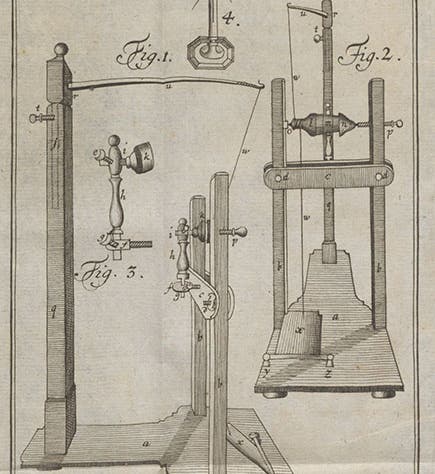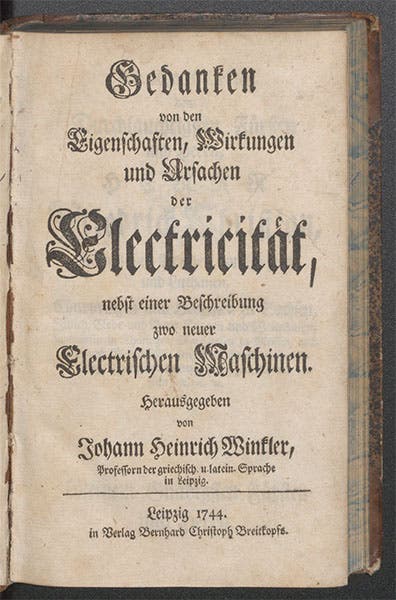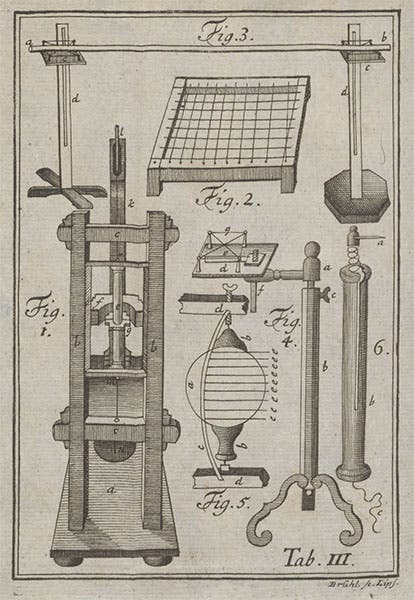Scientist of the Day - Johann Winkler
Johann Henrich Winkler (sometimes Winckler), a German electrical experimenter, was born Mar. 12, l703. In the early 1740s, electrical experimentation was all the rage in England and France, but it had yet to make inroads into the physics laboratories of German universities. Then that changed in a hurry, around 1742, as Christian August Hausen, Georg Mathias Bose, and Winkler, all at Leipzig, began making and buying electrical equipment and redoing the experiments of Stephen Gray in England and Charles-François Dufay in France. In 1719, Stephen Hauksbee in England had invented an electrostatic generator, a large globe that could be rotated by a treadle and then rubbed with a cloth or with the hand. But Gray and Dufay did most of their important experiments, discovering conduction and the two kinds of electricity, by rubbing glass or rubber rods with cloth or fur (respectively) and using those rods to attract or repel chaff, or electrify other objects. Both Bose and Winkler rediscovered Hauksbee's electrical machine. Bose seemed to be satisfied with the rotating glass globe, but Winkler took on the task of improving both the rotating electrostatic generator of Hauksbee and the rubbed rods of Gray and Dufay.
In 1744, Winkler published a book, Gedanken von den Eigenschaften, Wirkungen und Ursachen der Electricität: nebst einer Beschreibung zwo neuer electrischen Machinen (Thoughts on the Properties, Effects, and Causes of Electricity: Together with a Description of Two New Electrical Machines, 1744). His first engraving (and our first image) shows his new rotating generator, which uses essentially a beer stein without handle rotated very rapidly with a foot treadle and a bow spring return, just like a lathe. His other invention was a mechanically rubbed rod; in the book’s second engraving (third image), the rod is fixed in place, and the rubbing mechanism moves up and down around it, again activated by a foot pedal with bow return.
In the third and last engraving in his book (fourth image, just below), there is at the top an innocent looking device, fig. 3, a metal rod on two insulated supports. This is, I believe, the first illustration of a “prime conductor”, which had been invented the year before by Bose. The prime conductor was a device that could be used to accumulate the electrostatic charges produced by a generator, and it became a commonplace of most labs or salons where electric effects were explored or generated for entertainment. If you look at our post on abbé Nollet, the first three images all show prime conductors in use. The last one informs us that even a human being (usually a young lad) could function as a prime conductor.
Winkler played no role in the great electrical discovery of the 1740s, the Leyden jar, invented independently by Ewald von Kleist and Petrus van Musschenbroek in 1746. But Winkler investigated this new way to store electricity with great glee. It was reported that he persuaded his wife to touch a loaded Leyden jar, and that afterward, she found herself unable to walk. The account does not say how long she was incapacitated; one hopes it was for just a short while.
As the several links above show, we have written posts on a few of the early electrical experimenters, but we have not done Hauksbee, Gray, Hausen, Bose, or Musschenbroek, which is odd, because I have always been fascinated by the incunable decade of electrical investigation, the 1740s, when all sorts of new effects were being discovered, and theories to explain these effects were wild and convoluted, at least until Benjamin Franklin made sense of it all. Perhaps as we fill in some of these posts, I will have the courage (although probably not the expertise) to discuss some of these early theories of electrical action, so you can appreciate how hard it was to come up with a hypothesis that would explain electrical attraction, repulsion, attraction then repulsion, conductors and non-conductors, the Leyden jar, and lightning. It is no wonder that these experimenters sought relief in all manner of effluvia, vortices, and immaterial phenomena, and were still surprised with every new discovery.
Dr. William B. Ashworth, Jr., Consultant for the History of Science, Linda Hall Library and Associate Professor emeritus, Department of History, University of Missouri-Kansas City. Comments or corrections are welcome; please direct to ashworthw@umkc.edu.









